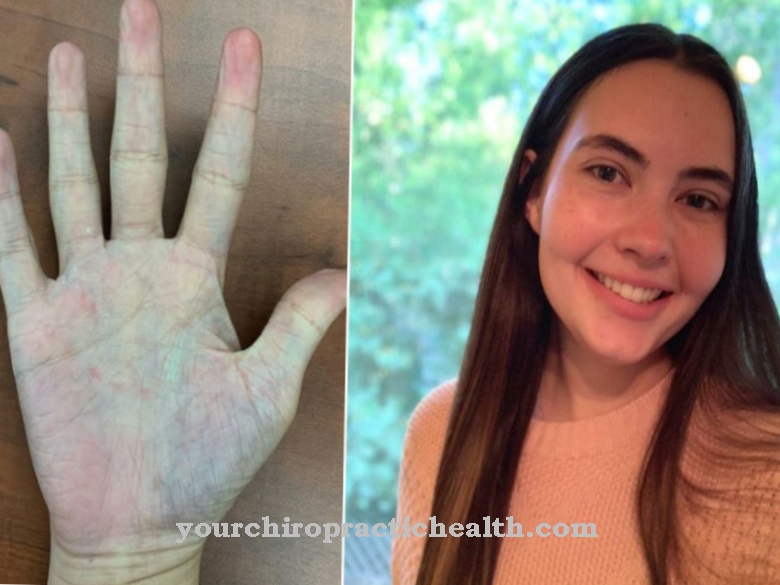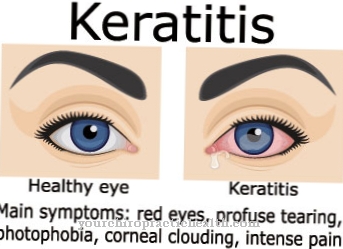The Arthrofibrosis is an inflammatory proliferation of connective tissue cells in a joint. The phenomenon is mainly observed after knee joint reconstructions and is therefore a postoperative complication. Treatment is carried out through arthroscopic revisions and physical and physiological therapies.
What is arthrofibrosis?

© ag visuell - stock.adobe.com
The fibrocytes are cells of the connective tissue. They lie between the individual fibers of the extracellular matrix and thus stabilize the connective tissue. In their shape they are spindle-shaped and equipped with long branched cell processes through which they can form solid networks. If the connective tissue increases pathologically, this clinical picture is referred to as fibrosis based on the fibrocytes.
Arthrofibrosis is specifically characterized by a pathological increase in fibrocytes, which occurs on the basis of inflammatory processes within a joint. A distinction is made between two different forms of arthrofibrosis: primary and secondary arthrofibrosis. In the primary form, there is a massive increase in connective tissue in the context of scar formation in a joint. The secondary arthrofibrosis is probably caused by mechanical factors.
The most important disease from this group is cyclopsyndrome. Arthrofibrosis occurs after anterior cruciate ligament reconstruction with an incidence between 4 and 35 percent. Arthrofibrosis has been observed particularly frequently in the context of arthroscopic interventions on the knee joint and, above all, the reconstruction of the anterior cruciate ligament.
causes
The causes of primary arthrofibrosis are largely unknown. However, joint reconstructions seem to be related to the phenomenon. Reduced physical activity after or before the operation is now considered a risk factor. Too little time between a reconstruction and an irritation in the joint can also be described as a risk factor. The same applies to perioperative pain that is countered with physiotherapeutic treatment.
Muscle training too early postoperatively or infections and bleeding in the joint can also cause arthrofibrosis. The same goes for rheumatoid arthritis and diabetes mellitus. Secondary arthrofibrosis, on the other hand, is usually preceded by incorrect placement of grafts or entrapment symptoms. The pathogenesis for both forms is based on the development of granulation tissue and interstitial edema.
This releases inflammation mediators. Because of a pathologically increased collagen synthesis, the fluid in the interstitial space is exchanged with the extracellular matrix. Type VI collagen is involved in the proliferation of fibroblasts. Some authors also call arthrofibrosis a pathological wound healing that triggers a cytokine reaction through the dysregulation of cytokines.
You can find your medication here
➔ Medicines for back painSymptoms, ailments & signs
The clinical picture of arthrofibrosis is extremely complex. Even if the symptoms can vary greatly in individual cases, painful and permanent restrictions on movement in the joint concerned are considered characteristic. Usually the skin becomes reddened and overheated in the corresponding area. Swelling is also common.
Often an effusion is formed or there are symptoms of entrapment with scar impingement. Apart from these key symptoms, no uniform picture can be described for arthrofibrosis. Sometimes the more or less severe restriction of movement of the affected joint occurs completely without any pain symptoms. A compelling clinical symptom described is a persistent restriction of mobility that includes more than ten degrees of extension and more than 125 degrees of flexion.
In extreme cases, arthrofibrosis can lead to a complete loss of function of the joint. In most cases, this phenomenon affects the knee joint. The swelling or redness and effusions on the skin do not necessarily have to accompany the problem. In most cases, however, the corresponding part of the body is heated.
Diagnosis & course
The timely diagnosis of arthrofibrosis can be difficult because of the heterogeneous clinical picture. Postoperative complications can also occur in the context of other clinical pictures. In the differential diagnosis, the postoperative lack of movement or immobilization and permanent restriction of movement can also be caused by a shrinkage of the associated joint capsule.
A CRPS can be performed to support a suspected anamnetic diagnosis of arthrofibrosis.In this way, however, symptoms of arthrofibrosis can only be detected in the rarest of cases. The course of arthrofibrosis depends heavily on the time of diagnosis. If the diagnosis is made too late, in extreme cases, for example, patients permanently lose their joint function and have to live with persistent restrictions on mobility.
Complications
Arthrofibrosis is itself a complication that can occur especially after surgical interventions on the knee joint. Due to the arthrofibrosis, most of the movements are usually associated with severe pain for the patient. This pain restricts the patient's movement to a relatively large extent.
They may need the help of other people. The affected area is often red and somewhat swollen. In the worst case, the joint can completely lose its function due to the arthrofibrosis. In this case, the patient can no longer move without walking aids, which leads to a strong reduction in quality of life.
Due to these restrictions, arthrofibrosis can also lead to psychological problems. The treatment usually takes place surgically. Its success depends heavily on the severity of the arthrofibrosis and cannot be universally confirmed. In most cases, however, the pain subsides and the joint can be moved again.
Special complications do not arise if treatment is given early. In addition to the surgical procedure, arthrofibrosis can also be treated with the help of heat and cold. These also do not lead to any further complaints.
When should you go to the doctor?
If you suspect arthrofibrosis, you should speak to the responsible doctor immediately. This is especially true when there are symptoms such as redness, swelling or increasing pain in the joints. If the affected joint is suddenly no longer as flexible as it used to be, it is advisable to see a doctor immediately. People who are prone to severe scarring are particularly prone to arthrofibrosis.
Other risk factors: poor mobility of joints and bones before the procedure, arthrofibrosis in other joints and disorders of the autonomic nervous system. The scarring can rarely also have genetic causes. If one or more of these pre-existing conditions exist, a quick visit to the doctor is recommended.
The doctor will diagnose the arthrofibrosis and can immediately initiate the appropriate treatment measures. If left untreated, the scarring can spread to other joints. At the latest when the mobility continues to decrease, the cause must be clarified medically. If there are new problems after the therapy, this should be reported to the responsible doctor.
Doctors & therapists in your area
Treatment & Therapy
The route of therapy depends on the type of arthrofibrosis. A surgical revision is usually used for secondary arthrofibrosis. Such a revision can be performed, for example, by removing the scar strands or excess connective tissue arthroscopically. If the restriction of movement is due to an incorrectly seated implant, however, a transplant adaptation is carried out.
This can be done on the knee joint, for example, as part of a cruciate ligament surgery that creates an enlargement of the knee roof. Primary arthrofibrosis is difficult to treat. Arthroscopic revisions can also be considered in this form of osteoarthritis, but usually have little success. In a primary form, the conservative treatment methods used are primarily physiotherapy to restore the ability to move.
NSAIDs or physical therapies with heat or cold can also be used. The same goes for electrotherapy and ultrasound therapies. Depending on the individual case, manual lymphatic drainage can improve the symptoms. If the arthrofibrosis persists despite the countermeasures, therapy with anesthesia mobilization and open arthrolysis is carried out. In individual cases, if the arthrofibrosis persists, it may be necessary to change the endoprosthesis.
Outlook & forecast
The prognosis of arthrofibrosis depends on the possible start of treatment. The earlier this takes place, the better the chances of recovery. Without treatment, the disease and the symptoms will progress. In addition, psychological problems often arise, which lead to a further reduction in well-being and quality of life.
With an early diagnosis and an immediate start of treatment, the various therapy options usually lead to rapid relief of symptoms. The patient can be completely free of symptoms within a few weeks. This applies if there are no further complications.
Often arthrofibrosis arises as a secondary disease. Regardless of the underlying disease, the arthrofibrosis must be treated separately. The start of treatment depends on the patient's health stability. There may be delays leading to an increase in pain. If the underlying disease cannot be cured sufficiently, the arthrofibrosis can develop again.
The prognosis for recurrent arthrofibrosis is also good under normal conditions and can be achieved within a short time in people with a stable immune system. If the arthrofibrosis is already at an advanced stage, the prognosis deteriorates significantly. Despite various treatment options, the success is usually only moderate and freedom from symptoms is not achieved.
You can find your medication here
➔ Medicines for back painprevention
According to current studies, if there are more than three weeks between the rupture of the cruciate ligament and the reconstruction, arthritis of the knee can usually be prevented. So far, there are no promising preventive measures related to other interventions or joints.
Aftercare
Direct follow-up care is usually not possible in the case of arthrofibrosis. The affected person is dependent on purely symptomatic treatment, since a causal treatment is usually not possible in this case. However, early diagnosis and treatment of arthrofibrosis have a very positive effect on the further course of this disease and can prevent further complications and symptoms.
In many cases, surgical interventions are necessary to alleviate the symptoms. After such an operation, the patient must rest and take care of his body. Above all, the affected joint should not be unnecessarily stressed. Sports activities are also to be avoided.
As a rule, the person affected is also dependent on physiotherapy measures to increase the mobility of the joint again. The exercises can often be carried out in your own home, so that the healing of arthrofibrosis is accelerated.
Since the quality of life of those affected is significantly reduced by the disease, they are often dependent on the help of their fellow human beings in everyday life. Loving care has a positive effect on the course of the disease. Contact with other sufferers of arthrofibrosis can also prove to be useful in order to exchange helpful information.
You can do that yourself
Primary or secondary arthrofibrosis mainly affects knee joints after surgery - even after minimally invasive arthroscopy. While the cause of secondary arthrofibrosis can be determined and usually corrected by an operative measure, the reasons for the development of primary arthrofibrosis are more speculative. It seems certain that joint irritations trigger inflammatory reactions which, as a counter-reaction, cause the formation of connective tissue (scar tissue).
If it is known that a surgical or arthroscopic procedure is to be carried out on a joint, it is advisable to incorporate self-help measures into everyday life to prevent arthrofibrosis. The most important self-help measures are to determine the optimal time for an operation. For example, if the cruciate ligament ruptures in the knee, it helps to wait at least six weeks before the cruciate ligament replacement operation, as shorter periods between the cruciate ligament tear and the operation increase the risk of developing arthrofibrosis significantly.
Another preoperative precautionary measure consists of targeted physiotherapy to keep the affected joint as flexible as possible. An immobile phase over a longer period of time would also increase the risk of arthrofibrosis. Targeted, individually tailored physiotherapy should also be started immediately after the operation. Physiotherapy can be carried out independently at home as a self-help measure in addition to therapy in the therapist's practice.

.jpg)


.jpg)
.jpg)
.jpg)






.jpg)

.jpg)
.jpg)











.jpg)